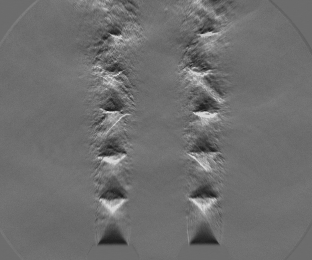My research broadly covers the topics of compressible and multi-phase fluid mechanics. For broader details on these topics, see the How It Works section of the page. To see news about recent publications, look here. To see the people who actually do most of the work, check out the team.
Active Research Projects:
The art of controlling multijet resonance in jet noise and power generation

This project aims to determine the mechanisms by which arrays of high speed jets interact. The project will combine experiments at multiple specialist facilities with analytical approaches to unlock the physics behind both steady and transient behaviour in high-speed multijets. Understanding multijet interaction mechanisms is crucial in the development of more efficient power-generation turbines, and the operation of high-speed flight vehicles. Expected outcomes of the project include deep insight into the characteristics of multijet arrays, and the forging of strong links with multiple international research centres. As well as fundamental knowledge, the project will facilitate improved efficiency in gas turbine systems, using pulsed-detonation combustion.
This work is undertaken with Prof. Damon Honnery of Monash University, Prof. Kilian Oberleithner of the Technical University of Berlin, Prof. Mo Samimy of Ohio State University, and Prof. Peter Jordan of Institut P'.
Supersonic Jet Impingement - A flow of critical importance

As noisy as supersonic jets are, the noise problems get worse when the jet strikes against a nearby surface. This is the phenomenon of "supersonic jet impingement", and it has broader applications than you might imagine. These applications range from the very large scale: the exhaust of rockets striking the launch pad during lift-off, to the very small scale, such as the development of needle-free drug delivery devices. We use both experimental (link to PIV page) and numerical techniques to try to understand the highly complex flow physics characterizing these supersonic impinging jets.
This work is undertaken with Prof. Julio Soria of Monash University, and Prof. Vassilis Theofilis of the Universidad Politecnica de Madrid, under the support of an Australian Research Council Discovery Project grant.
Improving respiratory drug delivery through targeted nozzle design

There are many medical conditions for which simultaneous treatment with multiple therapies is the best course of action. A novel way to maximize the efficiency of this treatment is to combine multiple drugs in a single particle, that is then delivered to the lung. To do this efficiently and safely requires a careful engineering of the particle at a microscopic level, by controlling the spray process that generates the particle. In this research we work with colleagues in Pharmaceutical Science, both industrial and academic, to develop an understanding of spray mechanics that will lead to optimized particle engineering, and thus maximize therapeutic efficacy.
This work is undertaken with Dr. Daniel Duke, Prof. Adrian Nield and Prof. Damon Honnery of Monash, Professer Paul Young of Sydney University and Dr. David Lewis of Chiesi Pharmaceutical. It is supported through an Australian Research Council Linkage Project, with support from Chiesi.
Past Research Projects:
Silencing the Screech Tone - Noise Suppression in Supersonic Jets

Anyone who has ever sat near the wing on a long distance flight is all too familiar with the concept of jet noise - the production of sound by the exhaust of jet engines. If we want to fly faster (and given Australia's Tyranny of Distance, we are surely well-motivated to do so), this noise problem becomes rapidly worse. Once the exhaust of a jet is moving faster than the speed of sound, new noise mechanisms come into play. Amongst these mechanisms is the phenomenon of "screech". A current focus of my research is understanding the mechanism of the screech tone, to develop more efficient ways to suppress it. This will help pave the way for a return to supersonic civilian transport. We conduct this research using a range of specialist experimental tools; see my descriptions of Particle Image Velocimetry (PIV) and schlieren imaging.
This work is undertaken with Prof. Damon Honnery, under the support of an Australian Research Council Discovery Project grant.
Droplet breakup for fuel and pharmaceutical sprays

Understanding how droplets of liquid break up in a flow of gas is important for a wide range of fields. Optimizing the injection of fuel into a piston or gas-turbine engine requires the ability to optimize the spray of fuel into the combustion chamber. This in turn requires an understanding of the primary and secondary atomization mechanisms. Pharmaceutical particles are typically either produced or delivered through a spray process; thus an understanding of how the drug-containing droplets break up is also critical to optimizing this process. In this research I applied optical diagnostics to study the role of turbulence in droplet breakup processes. This work is closely related to our pharmaceutical microparticle research.
This work was supported through a Monash University Faculty of Engineering Seed Funding Scheme.